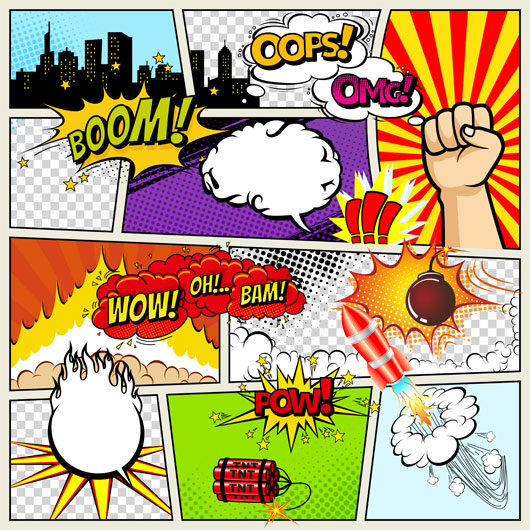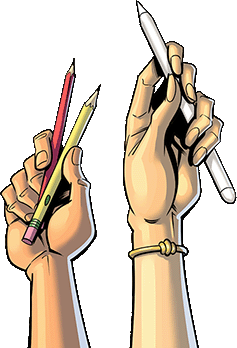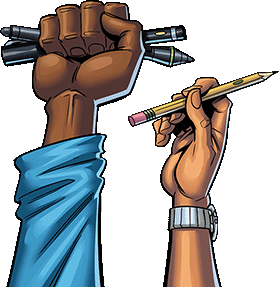How to Write a Comic Book in 4 Steps
Posted by Mary MacInnes on May 25, 2020
Every great comic book starts with an idea, but getting that idea from your head to paper to a finished product takes time and effort. There’s no right or wrong way to succeed in your creative process. Everyone’s process looks different, similar to how everyone learns in a particular manner.
Even though the process is incredibly subjective, centuries of creative writers have offered up advice as to how to best get some of those ideas onto paper. In the case of a comic book writer, these steps include some visual processes.
Here are some helpful steps that may aid you as you try to tell your story. Before any other step, you must learn to trust yourself. One of the most important steps you can take before any other is trusting your creative impulses. At the end of the day, it’s your story idea.
1. Idea to Script
While comic books and graphic novels tell stories blending both visual images and written words, it’s helpful to many to start with a script. Even though you’re a visual storyteller, write a comic book script to overcome blocks and provide a template at later stages.
When comic books are boiled down into words, they come out looking a lot like a short story. Your script format does not have to be perfect, but it should be complete. In other words, get it all down, every character and plot point, and even some of your chosen sound effects.
A page of your script could look like anything you’d like – a mind map, detailed outline, or storyboard. Whatever helps you get the idea from the inside of your head onto the paper is the process you should use.
It may be daunting for you as a comics writer to sit down to compose a script when you’re used to creating ideas in visual images, but there’s one step you can take that can help you beyond anything else – start writing.
Sometimes the hardest part of writing is putting the pen to paper (or fingertips to keyboard). Just make the commitment to sit down and write your script.
As you write it out or soon afterward, consider the act structure of your plot. After you’ve written it all down, it should have a clear beginning, middle, and end, no matter how avante-garde the finished product may be.
It should also have a conflict – or something that the protagonist wants that is challenging to achieve. Without tension and conflict, the plot becomes uninteresting and flat.
2. Comic Book Script to Layout
Once you’ve got it all down, you can start using your artistic abilities to make your written story come to life. Laying out your story is a painstaking process, and it helps to know some of the jargon before setting out to turn your words into images.
A comic book page is composed of tiers of panels. A panel is the individual square surrounding the image. In this panel can appear as a panel description – a shred of narrative describing pre-action or setting. The gutters are the spaces between the panels, and speech bubbles hold the characters’ dialogue.
Another integral part of a great comic is the camera angles. The Joker wouldn’t be quite so scary if he didn’t have the (imaginary) camera angle turned under his chin, making him ghoulish.
Consider how you want the scene presented in each panel. Close-ups, wide shots, panoramic, or a busy fight scene – all these scenarios are improved by establishing shots that complement what’s going on.
A great comic book wouldn’t be great without another critical element – sound effects. Spider-Man’s antics aren’t quite so compelling without the telltale thwip of his web shooter.
Make sure to include any pow, bang, or shazam in your writing panel so that you remember on the next go-around.

3. Color and Inking
After you draw the comic, you can then concentrate on color and inking. For many comic book writers, the inking and colorwork is the realm of another artist altogether.
Some authors are also artists, and both write and draw their work. Others outsource by hiring artists to do the drawing, coloring, and inking for them. In this scenario, learning to collaborate on your project is vital.
You have to hand over some creative control to the artist so they can put their mark on the piece. This is hard for some writers, but it gets easier with time.
4. Finding a Publisher
Once you’ve put in all this hard work, it’s time to find the ideal publisher to bring your work to life. You want a company with a strong track record, excellent customer service, and superb attention to detail.
Your publishing company is your guide through the sometimes-confusing aspects of the publishing world. Although having the idea is what sets this plan into motion, the publishing process is what brings it to fruition.
The road to publishing has never been murkier. Self-publishing and e-books hit the traditional publishing world like a tsunami, and they have been coming up with workarounds ever since.
If you choose to self-publish comic book, which many people find cost-effective and gratifying, pick the company that can do your story justice.

Final Thoughts
At Comix Well Spring, we appreciate comics as much as you do. We have worked with authors and artists since 2011 to create their masterpieces. With over 7,000 global clients, we are there with you on every step of the publishing process.
You can choose from a variety of binding options, custom-sized pages, and full color or black-and-white options. At Comix Well Spring, we can offer our clients phenomenal turnaround time, including expedited printing, and 24-hour customer service responses.
Creativity is one of humankind’s greatest achievements. Creating a story and building a world solely out of ideas is an unbelievable feat. It takes a lot of hard work and dedication to get that creative spark into comic book form.
That’s where Comix Well Spring comes in. As experts in our field, we know how much you want your ideas to shine, and we’re here to make it happen for you.


